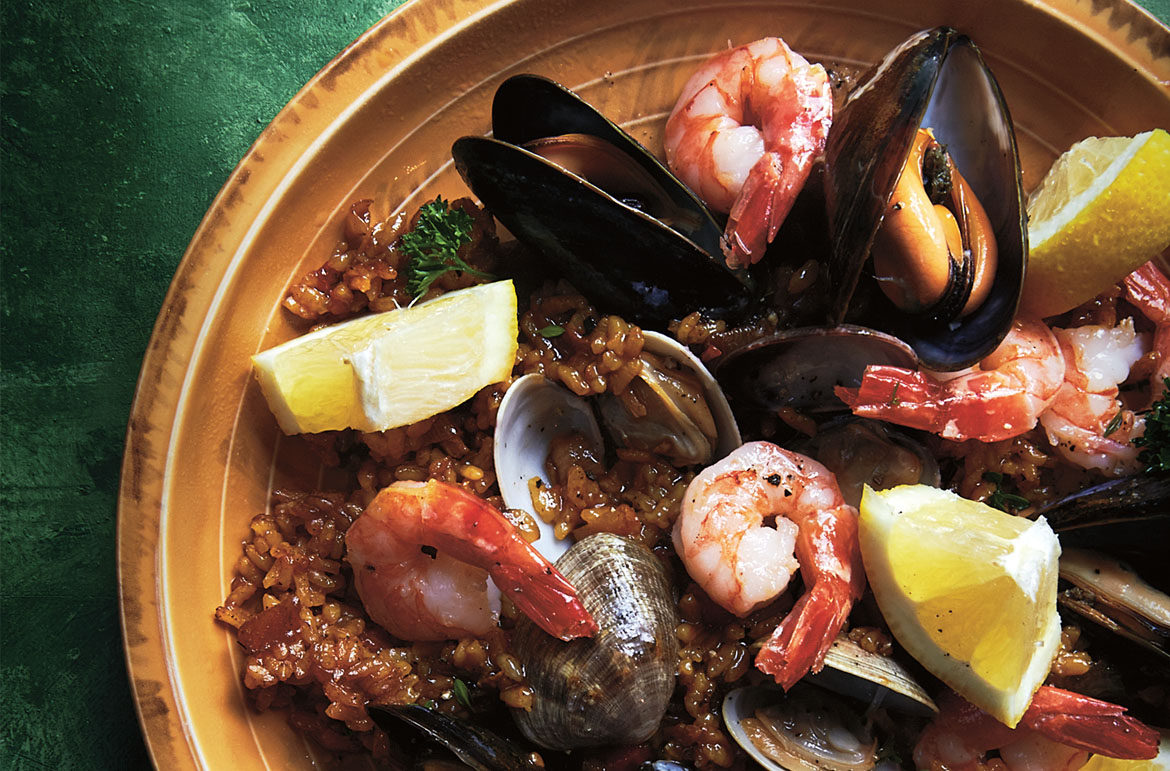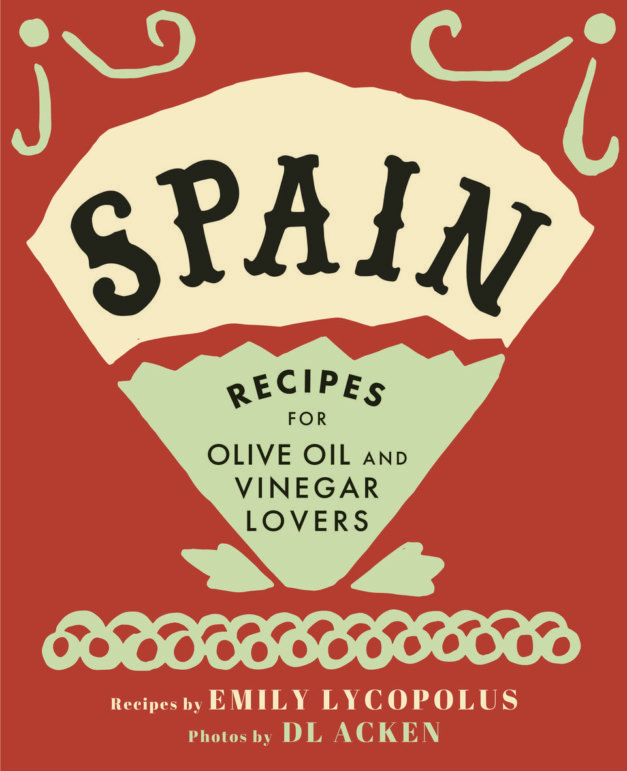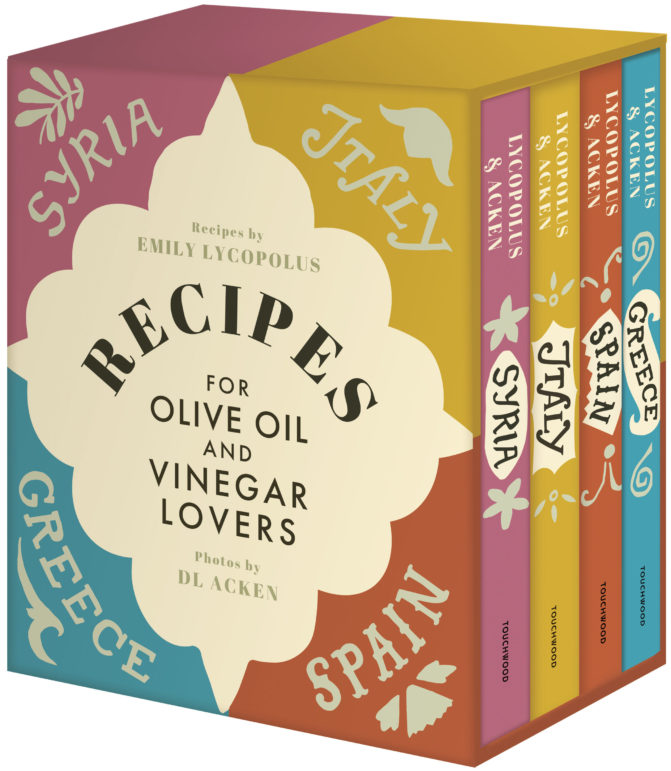Traditional Spanish cooking is famous for its fragrant spices, fresh herbs, and delicate touch of citrus. Whether you’re a novice to Spanish cuisine or a seasoned cook, the recipes in Spain: Recipes for Olive Oil and Vinegar Lovers by Emily Lycopolus & D.L Acken (TouchWood Editions) will inspire and guide you through the finest classic Spanish recipes including tapas, mains, soups, and cocktails.
While technically Spanish Paella Day is an unofficial holiday, we are on board with any excuse to celebrate through food. Celebrate by cooking a Seafood Paella featured in Spain. Paella is a rice dish made with different kinds of meat and beans, flavoured with saffron and paprika. Did you know that the word paella means “pan” in Spanish?
Seafood Paella
This version of paella is made with a mixture of shellfish and white fish, as is traditional in seaside communities. If you’re a shellfish person, feel free to substitute more shellfish for the fish, and, of course, vice versa.
A paella pan is the only way to go for the paella recipes.
Serves six.
(Prefer a meat-based paella? Grab a copy of Spain the cookbook and check page 98.)
- 12 clams
- 12 mussels
- 6 small squid, cleaned
- 12 jumbo shrimp or 18 small shrimp
- 1 lb white fish, such as cod, cleaned
- 6 cups warm fish stock
- 6–8 strands of saffron
- 1 small red onion
- 6 cloves garlic
- 2 red bell peppers
- 4 Roma tomatoes
- 1/4 cup Rosemary infused olive oil
- 2 tsp sea salt
- 2 Tbsp Grapefruit white balsamic vinegar
- 2 tsp sweet paprika
- 2 1/2 cups short-grain rice
- Curly parsley for garnish (optional)
Start by making a fire in a charcoal BBQ with 80–90 briquettes. While the grill is heating up, prepare all the ingredients.
Scrub the clams and mussels to get any bits of dirt off the shell, then trim the beards and rinse them well. Discard any clams or mussels that have broken shells or are not tightly closed. Set aside in a bowl.
Cut the cleaned squid in half and ensure that the beaks have been removed. Then slice them into 1-inch pieces and place them in a separate bowl.
Rinse the shrimp and remove the shells, if desired, leaving on the tails for ease of eating. Place them in a separate bowl.
Rinse and clean the fish, then cut it into large bite-size pieces. Place the pieces in the bowl with the squid. Put all the seafood in the fridge until you’re ready to cook.
Place the stock in a large saucepan over medium heat and add the saffron threads, bring to a simmer, and then turn down the heat to low to keep the stock warm.
Finely chop the onion and crush the garlic, leaving the cloves in large pieces. Place them in a separate small bowl.
Chop the peppers and tomatoes, and place each in separate bowls as well.
When the fire is hot and the coals are white, place your paella pan on the grill and drizzle in the olive oil. Add the onions and garlic to the pan and sauté for 2–3 minutes, until tender. Sprinkle them with the 2 tsp salt, add the peppers, and continue to cook, stirring, for an additional 2–3 minutes.
Add the balsamic. Allow the onions to soak it all up and scrape up any bits sticking to the pan. Add the tomatoes and sprinkle with the paprika, continuing to stir until the tomatoes are soft and have broken down. If the pan is completely dry, add a little more olive oil. Add the rice, stirring well to ensure that it’s well distributed and incorporated into the vegetables. Spread the rice around the paella pan in an even layer, and then place the pieces of fish and the squid evenly on top.
Gently pour 4 cups of the stock over the rice. It is very important from this point on that you don’t stir the rice. Socarrat is the crispy golden rice that forms at the bottom of the dish, and it won’t form if the rice is stirred.
Let the paella cook for 10–15 minutes, uncovered, until the rice is almost completely tender and only has a bit of crunch left and the pan is almost completely dry.
Nestle the clams and mussels evenly around the rice. If you’re using jumbo shrimp with the shell on, add them now. If you’re using small, shelled shrimp, wait to add them. Pour the remaining 2 cups of stock over the rice and cook for another 5 minutes, covering the grill with a lid to allow the steam to cook the clams and mussels. If you’re using small, shelled shrimp, add them now. Check the rice to see if it’s tender, adding a little more stock or water if it still has a crunch to it. If it’s tender, cook it for an additional 2 minutes to ensure the
(Spain also has an oven-cooking option if you prefer on page 99. For this version, start with the onions and add the fish and squid to the paella pan before putting it in the oven to bake. Add the shellfish 5 minutes before the paella is finished to ensure the seafood doesn’t overcook.)
Seafood paella doesn’t keep well, so enjoy it the day it is made. With the seafood removed, the rice will keep for up to 3 days in an airtight container in the fridge.
Images and recipes courtesy of TouchWood Editions
One of four in a series, Spain: Recipes for Olive Oil and Vinegar Lovers is a beautiful, full-colour cookbook that shows readers how to create and enhance spectacular Spanish dishes by using specialty olive oils and
Emily Lycopolus is a recipe developer living in Victoria, BC, the author of six olive oil-focused cookbooks with TouchWood Editions, and a level two olive oil sommelier. She is the co-founder of eatcreative.ca, a food-driven creative content agency, and the founder of The Olive Oil Critic (oliveoilcritic.com). Her family owns an olive grove in central Italy, where her love of olive oil began.
Photographs by Danielle (DL) Acken, a Canadian-born international food writer and photographer. DL splits her time between London, UK and her farm studio on Canada’s beautiful Salt Spring Island.
If you enjoyed this recipe, check out the other books in the series: Italy, Syria, and Greece, or buy the gorgeous 4-book boxed set.



